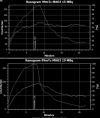High-Pressure Balloon Dilatation in Infants with Primary Obstructive Megaureter: A Single-Center Case Series
- PMID: 40528636
- PMCID: PMC12208928
- DOI: 10.5152/tud.2025.24045
High-Pressure Balloon Dilatation in Infants with Primary Obstructive Megaureter: A Single-Center Case Series
Abstract
Objective: The aim was to evaluate the efficacy of high-pressure balloon dilatation (HPBD) for primary obstructive megaureter (POM) treatment in infants. Methods: The authors retrospectively reviewed medical records of 5 infants diagnosed with symptomatic or progressive POM and treated with HPBD between 2015 and 2022 in one hospital, analyzing changes in ureteral and anteroposterior pelvic diameters, Society for Fetal Urology grading, parenchymal thickness, differential renal function, complications, and subsequent surgical needs. Results: High-pressure balloon dilatation was performed on 5 patients, median age 5 months. No statistically significant changes were detected in ureteral diameter (median 11.0-7.0 mm, P = .125), anteroposterior diameters (median 21.5-18 mm, P= .255), parenchymal thickness (median 5.0-5.0 mm, P = .317), or differential renal function post-procedure. Follow-up was median 34 months. Three patients showed improvement in obstructive renogram findings. Complications were primarily related to guidewire insertion and double-J stent placement. Two patients, both younger than 6 months, required open ureteral reimplantation. Conclusion: High-pressure balloon dilatation serves as a minimally invasive approach for POM but is not universally effective, with a high complication rate and 40% of infants needing open surgery post HPBD.
Conflict of interest statement
Figures


Similar articles
-
Endoscopic dilatation/incision of primary obstructive megaureter. A systematic review. On behalf of the EAU paediatric urology guidelines panel.J Pediatr Urol. 2024 Feb;20(1):47-56. doi: 10.1016/j.jpurol.2023.09.005. Epub 2023 Sep 13. J Pediatr Urol. 2024. PMID: 37758534
-
Endoscopic treatment of primary obstructive megaureter with high pressure balloon dilation in infants.J Pediatr Urol. 2024 Feb;20(1):67-74. doi: 10.1016/j.jpurol.2023.09.007. Epub 2023 Sep 16. J Pediatr Urol. 2024. PMID: 37783596
-
Laparoscopic surgery for elective abdominal aortic aneurysm repair.Cochrane Database Syst Rev. 2017 May 4;5(5):CD012302. doi: 10.1002/14651858.CD012302.pub2. Cochrane Database Syst Rev. 2017. PMID: 28471523 Free PMC article.
-
Drug-eluting balloon angioplasty versus uncoated balloon angioplasty for peripheral arterial disease of the lower limbs.Cochrane Database Syst Rev. 2016 Aug 4;2016(8):CD011319. doi: 10.1002/14651858.CD011319.pub2. Cochrane Database Syst Rev. 2016. PMID: 27490003 Free PMC article.
-
Guided tissue regeneration for periodontal infra-bony defects.Cochrane Database Syst Rev. 2006 Apr 19;(2):CD001724. doi: 10.1002/14651858.CD001724.pub2. Cochrane Database Syst Rev. 2006. Update in: Cochrane Database Syst Rev. 2019 May 29;5:CD001724. doi: 10.1002/14651858.CD001724.pub3. PMID: 16625546 Updated.
References
-
- Braga LH D’Cruz J Rickard M Jegatheeswaran K Lorenzo AJ. . The fate of primary nonrefluxing megaureter: a prospective outcome analysis of the rate of urinary tract infections, surgical indications and time to resolution. J Urol. 2016;195(4 Pt 2):1300 1305. (doi: 10.10.1016/J.JURO.2015.11.049) - DOI - PubMed
LinkOut - more resources
Full Text Sources
